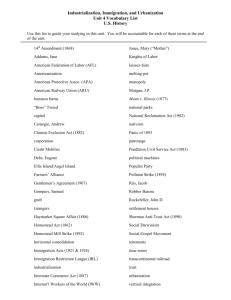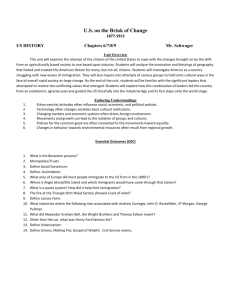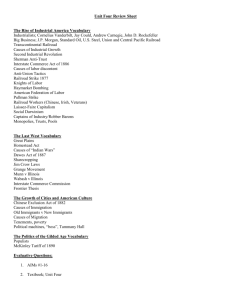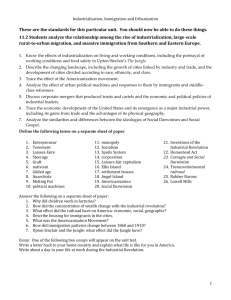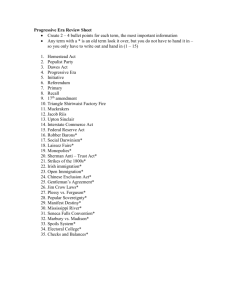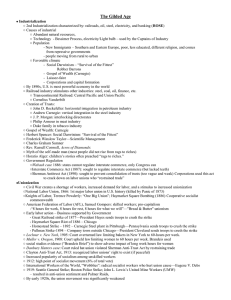Industrial Supremacy and the Gilded Age 1850s-1900’s AP History
advertisement
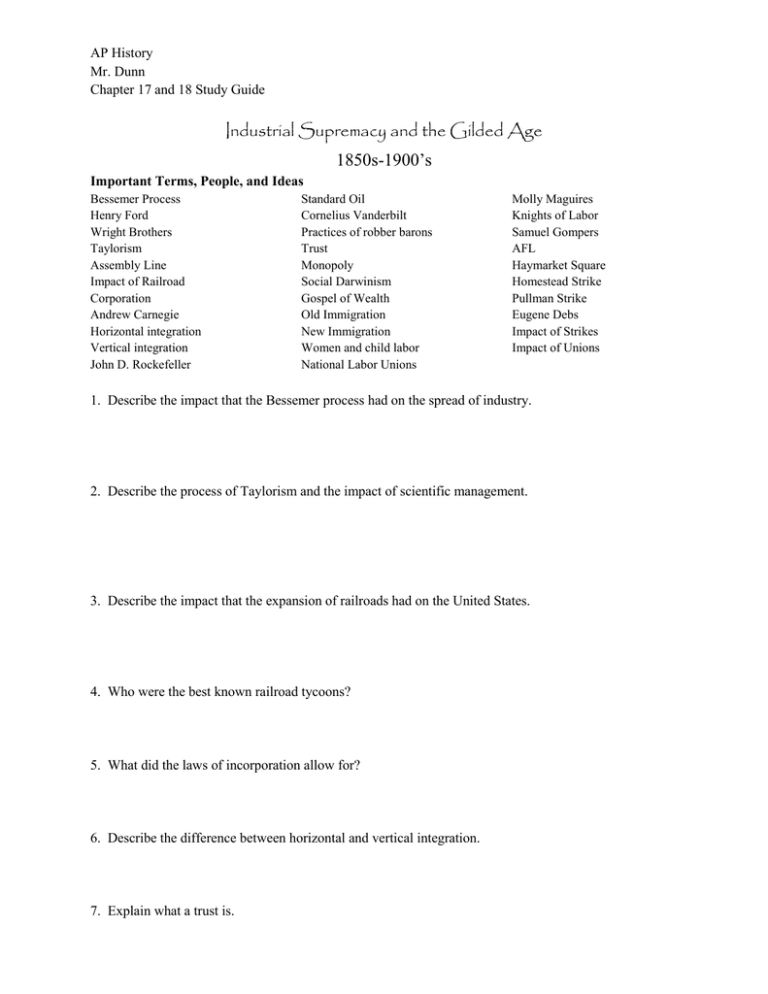
AP History Mr. Dunn Chapter 17 and 18 Study Guide Industrial Supremacy and the Gilded Age 1850s-1900’s Important Terms, People, and Ideas Bessemer Process Henry Ford Wright Brothers Taylorism Assembly Line Impact of Railroad Corporation Andrew Carnegie Horizontal integration Vertical integration John D. Rockefeller Standard Oil Cornelius Vanderbilt Practices of robber barons Trust Monopoly Social Darwinism Gospel of Wealth Old Immigration New Immigration Women and child labor National Labor Unions Molly Maguires Knights of Labor Samuel Gompers AFL Haymarket Square Homestead Strike Pullman Strike Eugene Debs Impact of Strikes Impact of Unions 1. Describe the impact that the Bessemer process had on the spread of industry. 2. Describe the process of Taylorism and the impact of scientific management. 3. Describe the impact that the expansion of railroads had on the United States. 4. Who were the best known railroad tycoons? 5. What did the laws of incorporation allow for? 6. Describe the difference between horizontal and vertical integration. 7. Explain what a trust is. 8. Describe what a holding company is. 9. Describe the corruption found in the rise to power and prominence of the tycoons. 10. Why did many industrialists seize on the theory of Social Darwinism? 11. Describe the ideas found in Andrew Carnegie’s book the Gospel of Wealth. 12. Describe the dangers of monopolies. 13. Describe the two different sources of migration that contributed to the labor force. 14. Describe the shift in immigration patterns that created a new source of immigration. 15. Why did the hiring of women and children as factory workers increase? 16. Explain why child labor laws had a limited impact. 17. The Great Railroad Strike When: Why: What happened? How did it end? What did it demonstrate? 18. Describe the differences between the Knights of Labor and the AFL. 19. Haymarket Square When: Where: Who: Why: How was it viewed by middle class Americans? 20. Homestead Strike Who: When: Where: Why: How did it end? Impact on the union: 21. Pullman Strike Who: When: Where: Why: How did it end? 22. Explain why workers failed to make greater gains. The Age of the City The Gilded Age 1850s-1900’s Important Terms, People, and Ideas Urban Growth Migrations Ethnic communities Americanization Nativism Xenophobia Tenements Jacob Riis Urban transportation Problems of City life Political Machines Urban boss Graft and corruption The Birth of a Nation Importance of Saloons Darwinism 23. Explain the different reasons people moved to the cities. 24. Describe the difference between the old immigrants and the new immigrants. 25. Describe what an ethnic neighborhood is and the reasons why they were formed. 26. How did Native born Americans encourage assimilation of immigrants? 27. Why did Nativism rise with the rising immigration? 28. Describe the anti-immigration groups that formed and what their platforms were. 29. Why did immigration restrictions have limited success? 30. Describe the evolution of the tenement. 31. Who was Jacob Riis and what did he do? 32. What type of improvements were made in public transportation? 33. Create an outline for the section titled Strains of Urban Life and write it on the back of this page. 34. Describe the impact the saloon had on urban life. 35. Describe the schism that developed due to the belief in the theory of Darwinism.
